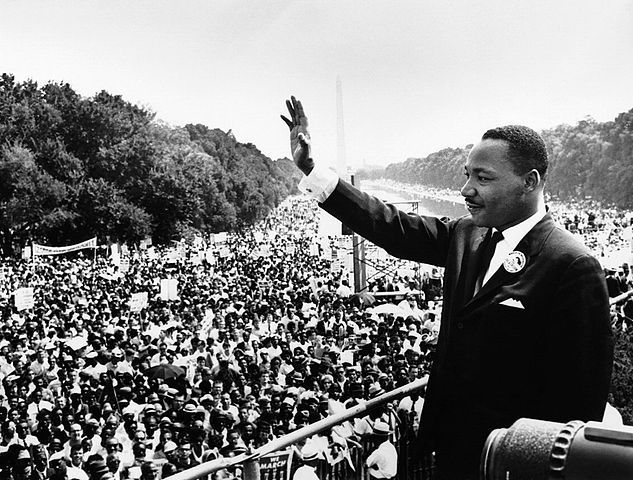LOS ANGELES - As we reflect on Doctor Martin Luther King Junior this
day we should all (hopefully) know and understand the legacy the civil rights
leader left, and one unique lasting testament Mr. King left throughout the
country are the hundreds of streets named in his honor. According to a 2006
East Carolina University study it is believed that at least 730 streets are
named after Mr. King.

Doctor Martin Luther King Jr. addressing the crowd from the steps of the Lincoln Memorial where he delivered his historic, famous, “I Have a Dream,” speech during on August 28, 1963, in Washington, D.C. Photograph in public domain.

Doctor Martin Luther King Jr. addressing the crowd from the steps of the Lincoln Memorial where he delivered his historic, famous, “I Have a Dream,” speech during on August 28, 1963, in Washington, D.C. Photograph in public domain.
It would be 1983 Los Angeles would see Santa Barbara Avenue
in the South L.A. area become Martin Luther King Jr. Boulevard, and just in
time for the 1984 Summer Olympics.
So just how did L.A. get one of its streets named after Mr.
King? Well, it partly involved Stevie Wonder and Jesse Jackson.
The transformation from Santa Barbara Ave. to Martin Luther
King Blvd. began with businessman Celes King III. Mr. King III strongly
believed L.A. should and must have a street named after the civil rights
activist.
Of course nothing is as easy it seems, and personal partisan
politics got in the way then, as they do today, in naming a street after Mr. King, because Celes was not entirely
thrilled to turn to Mayor Tom Bradley about the idea, because Mr. Bradley was
not a fan of Celes. Why, well, Celes was a Republican, and in fact was
one of the most prominent African-American Republicans in the country at the time. Now it really did not help
matters that Celes worked hard to keep the Democrat Mr. Bradley from getting elected and
reelected mayor.
So knowing this was not going to be an easy pitch Celes took
his idea to L.A. City Councilman Robert Farrell. Whether it was because Mr.
Farrell was an active participant in the civil rights movement and Freedom
Rider who's 8th District was in the South L.A. area, or perhaps another reason
altogether, Mr. Farrell
liked the idea.
Many streets were considered, but the reason Santa Barbara
Ave. was chosen is that it ran west-east and did not go through numerous other
council districts, unlike many north-south streets, according to Mr.
Farrell. The proposed street name change would only run through two other
council districts, and this proposal would hopefully garner the very important needed support of the full L.A. City Council.
Right after the street name change proposal came the protests. Many businesspeople objected to the street name change because it would apparently be a financial burden to change their business cards and letterheads, and then various city
departments loudly objected to the street name change for mainly budget
reasons. Then there were a lot of people in the community who objected to this
change simply because it was Celes' idea (again, personal partisan politics
have not changed much in 30 years).
As the debate raged in L.A. City Hall word got around that
Jesse Jackson would be in town for the Urban League’s national convention. One
of Mr. Farrell's council staff members was Gwen Green, and Ms Green once worked
with Martin Luther King Jr., and happened to know Mr. Jackson from her days
working with Mr. King. After making a series of telephone calls Ms. Green asked
Mr. Jackson to come speak at a city council meeting and hopefully broker some kind of peace deal in the various warring
factions over the proposed street name change.
Not only did Mr. Jackson come in to speak, but also the National
Rainbow Coalition founder brought along one Stevie Wonder, who also spoke at
the meeting. The words said by Mr. Jackson and Mr. Wonder worked, because
shortly after the city council voted unanimously in 1983 to pass the motion to
rename Santa Barbara Ave., Martin Luther King Jr. Blvd.
To celebrate the occasion the first Kingdom Day Parade was
held on the street, and has since become an annual tradition every Martin
Luther King Jr. Day.
Today Martin Luther King Blvd., sometimes called just
"MLK" or MLK Blvd, or King Blvd, and is about five miles long beginning near Jefferson
High School at Hooper Ave. and ending near Rodeo Road.
It should be noted that Santa Barbara Ave. was not named
after the famed city up the coast, but rather named after Saint Barbara, a
saint of the Middle Ages who was allegedly tortured and beheaded by her pagan
father for refusing to denounce her newly acquired Christian faith. The word
“allegedly” is used as there have been doubts among many
scholarly and theologian historians about the accuracy of St. Barbara's
account.
Now you know a little bit on how Martin Luther King Blvd.
came to be in the City of Angels.